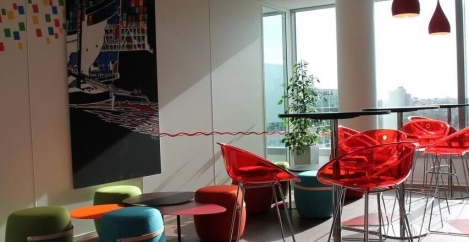October 25, 2016
How tech giant EMC standardised the design and management of its office portfolio 0
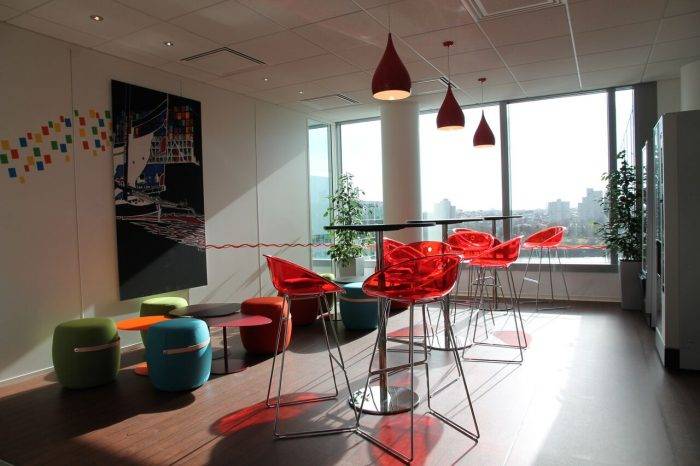 This summer’s headlines have been full of discord, a cacophony of angry voices either directed at continental Europe, or at the Brexiters who voted for Britain to leave the European Union. But EMC, a global leader in information technology-as-a-service which has recently been acquired by Dell, is a leading light of European integration through its One Team approach to workplace management and design across Europe, the Middle East and Africa (EMEA). Over the past three years, the EMC Global Real Estate and Facilities Team (GREF), which supports more than 12,000 people in around 130 office locations across 50 countries in EMEA, has transformed from a group operating independently, to a fully-aligned team which provides a uniform and standardised approach to workplace delivery and management to enable greater business success.
This summer’s headlines have been full of discord, a cacophony of angry voices either directed at continental Europe, or at the Brexiters who voted for Britain to leave the European Union. But EMC, a global leader in information technology-as-a-service which has recently been acquired by Dell, is a leading light of European integration through its One Team approach to workplace management and design across Europe, the Middle East and Africa (EMEA). Over the past three years, the EMC Global Real Estate and Facilities Team (GREF), which supports more than 12,000 people in around 130 office locations across 50 countries in EMEA, has transformed from a group operating independently, to a fully-aligned team which provides a uniform and standardised approach to workplace delivery and management to enable greater business success.
Drivers for change
But what were the drivers behind this innovative, award-winning approach? The EMC mission is to be innovative, relevant, trusted, engaged, approachable, and fun. The brand personifies a global community of passionate innovators and inspired problem-solvers supported by an organisation that is a great place to work.
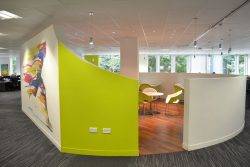 But in 2013 the real estate and facilities team did not always align to that mission and vision. “Attention wasn’t always focused on the customer experience”, acknowledges Ken O’Mahony, Senior Director EMEA for GREF at EMC. EMC is entrepreneurial, fast moving and requires constant innovation to remain competitive in the marketplace. Attracting and retaining top talent is key. The GREF team needed to up the ante in terms of its service offering to attract this talent – especially when other technology firms use their workplaces so effectively in this way. “It is key that we create a great employee experience so we can attract and retain the best talent in the industry. We are constantly looking for innovative ways to drive positive business results throughout the organisation and separate ourselves as an employer of choice”, says Kellie Crantz, Vice President, Talent Strategy and Development at EMC.
But in 2013 the real estate and facilities team did not always align to that mission and vision. “Attention wasn’t always focused on the customer experience”, acknowledges Ken O’Mahony, Senior Director EMEA for GREF at EMC. EMC is entrepreneurial, fast moving and requires constant innovation to remain competitive in the marketplace. Attracting and retaining top talent is key. The GREF team needed to up the ante in terms of its service offering to attract this talent – especially when other technology firms use their workplaces so effectively in this way. “It is key that we create a great employee experience so we can attract and retain the best talent in the industry. We are constantly looking for innovative ways to drive positive business results throughout the organisation and separate ourselves as an employer of choice”, says Kellie Crantz, Vice President, Talent Strategy and Development at EMC.
There was also a need for improved compliance, risk mitigation and agility to put in place the foundation for the future growth of the business, particularly focused on emerging markets. With EMC developing into new markets, a platform capable of expanding, contracting and cross border delivery was required to enable the business and retain efficient systems and processes.
An additional requirement was cross-functional and regional coordination on certain service initiatives, particularly around office design. The team was challenged to become more efficient, to enable and enhance sales, productivity and to contribute towards EMC being a ‘Great Place to Work’.
The journey
Over the course of the last three years, the GREF team set about changing the way it engaged with its facilities service partners. Rather than have individual relationships with 14 different Integrated Facilities Management (IFM) partners, it created a One Team approach whereby the competitive organisations were able to put the competition aspect aside and work together for the good of the EMC business with aligned values, vision and mission. Part of that journey was about recruiting Bruce Barclay, who comes from a hotel and property background, to introduce the hospitality sector’s ‘guest experience’ culture and service delivery principles into EMEA operations and drive the transformation programme. Barclay is now Senior Manager, EMEA Facilities Operations.
With the creation of a strong values-based real estate and facilities team in motion, underpinned by single unifying operating platform, O’Mahony was able to accelerate EMC’s Next Generation Office (NGO) programme, that commenced in 2010. He made it a key focus area and GREF service offering in EMEA. The Next Generation Office sets out a new way of working for EMC, moving away from individual assigned desks, to standards in desk-sharing and use of collaboration spaces while also introducing a new look and feel to EMEA offices.
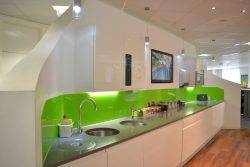 The NGO standard sets out expectations of an EMC office wherever it is located in EMEA. It includes recommendations for the space allocated to reception areas; the allocation of private offices; the size of different meeting rooms and their furniture and technology requirements; the location, design and components in break out and collaboration areas; and details of the specification for furniture for different areas from task chairs to workstations, pedestals, reception and the size of storage lockers for mobile workers. The NGO standards, documentation and rollout, managed by Barbara O’Sullivan, Senior Manager – Real Estate and Project Management for EMC in EMEA, also sets out the desk sharing ratios, which are dependent on the role and range from individual assigned desks for roles in finance, HR and legal to 3:1 or 5:1 for more mobile workers such as sales and customer services. Desk sharing will typically fall within the range of 60 – 70 per cent of all workstations in sales offices. A standards review is conducted annually to ensure the NGO model stays relevant to the real estate strategy of EMC and the workplace of the future.
The NGO standard sets out expectations of an EMC office wherever it is located in EMEA. It includes recommendations for the space allocated to reception areas; the allocation of private offices; the size of different meeting rooms and their furniture and technology requirements; the location, design and components in break out and collaboration areas; and details of the specification for furniture for different areas from task chairs to workstations, pedestals, reception and the size of storage lockers for mobile workers. The NGO standards, documentation and rollout, managed by Barbara O’Sullivan, Senior Manager – Real Estate and Project Management for EMC in EMEA, also sets out the desk sharing ratios, which are dependent on the role and range from individual assigned desks for roles in finance, HR and legal to 3:1 or 5:1 for more mobile workers such as sales and customer services. Desk sharing will typically fall within the range of 60 – 70 per cent of all workstations in sales offices. A standards review is conducted annually to ensure the NGO model stays relevant to the real estate strategy of EMC and the workplace of the future.
Natural light plays an important role in the success of the NGO space. The standard recommends that 50 per cent of available exterior glazed elevations are given over to open plan space. The standard discusses the look and feel of external and internal signage and graphics and includes detailed standards for IT, as you might expect of an IT company. CISCO VoIP is being rolled out across all offices while larger facilities have impressive Telepresence suites.
Service provision and workplace uniformity is important because EMC operates internationally. “EMC employees are very mobile,” explains Barclay. “One day someone might be working in London, the next in Brussels and the week after that in Dubai. We want the work environment in all locations to be of the same standard and deliver consistent workplace experiences.”
There are naturally regional cultural variations, he explains. Some European countries are louder and more expressive than others and that might require specific education on how to use the space and fine tuning of office etiquette by local management. He likens it to coffee. “The brand and taste of coffee might differ in the 50 countries where we serve it, but the quality of the coffee dock amenity is of the same high level everywhere. Similarly, the workplace must be the same high standard everywhere.”
 Barclay, who most recently worked for Movenpick Hotels and Resorts, describes it as a tricky balancing act. “When I was at Movenpick, we wanted guests to have a consistent Movenpick experience wherever they may be and we had many ‘signatures’ that differentiated us in the market such as the arrival experience, Swiss breakfast buffet and room presentation items, so we had to have consistency with those elements. But when you walk into the reception of a Movenpick in Dubai you know that you’re in the UAE, and when you walk into the Hanoi hotel you appreciate that you’re in Vietnam and that was achieved through décor, theming, and employee uniforms which all have a local flavor. It’s the same with the EMC offices. It’s a balancing act of respecting local culture and promoting a local experience to a point in terms of the look and feel, but office function and supporting FM service excellence is the same in London as it is in Dubai.”
Barclay, who most recently worked for Movenpick Hotels and Resorts, describes it as a tricky balancing act. “When I was at Movenpick, we wanted guests to have a consistent Movenpick experience wherever they may be and we had many ‘signatures’ that differentiated us in the market such as the arrival experience, Swiss breakfast buffet and room presentation items, so we had to have consistency with those elements. But when you walk into the reception of a Movenpick in Dubai you know that you’re in the UAE, and when you walk into the Hanoi hotel you appreciate that you’re in Vietnam and that was achieved through décor, theming, and employee uniforms which all have a local flavor. It’s the same with the EMC offices. It’s a balancing act of respecting local culture and promoting a local experience to a point in terms of the look and feel, but office function and supporting FM service excellence is the same in London as it is in Dubai.”
As a Next Generation Office standard is introduced, employees are trained in the new workplace etiquette, from a clear desk policy and not personalising the workstations to using hot desks and collaboration space. “This is an area which is often overlooked,” says Barclay. “Employees are given a new space but not told how to use it. Open plan noise etiquette is particularly important, so we provide small break-out rooms and pods for longer phone and video calls. Our local FM teams play a major role in maintaining the workplace etiquette, so it is critical they are aligned to our strategy and standards.”
About 67 per cent of the standard office portfolio (by area) now has a Next Generation Office design, and the team is gradually working through the remaining portfolio. All new offices and relocations are delivered to NGO standard, using UK-based project management and design consultant firm Atlas Associates, along with locally engaged project managers.
The programme aligns with EMC’s demographic. While Barclay acknowledges that he is ‘old school’ and rather likes having personal possessions on his desk, he recognises that many of EMC’s younger employees are very mobile and enjoy working in a variety of spaces within the offices, in cafés, on trains, in client sites and at home. “Our job is to ensure they have the technology to enable them to work wherever and however they want to.”
While the design of each office is important, Barclay is firmly rooted in the need for the workplace to enable the business rather than for it to just look trendy. He believes the starting point must be a deep understanding of the business both at a strategic level and operational level. “Of course the workplace must reflect the brand” he says, “but it must also enable talent attraction, productivity, innovation and business agility as well as meet the financial need of the business.”
Facilities-as-a-Service
The requirements for each new fit-out or building is carefully analysed through EMC’s new Facilities-as-a-Service (FaaS) business model. FaaS links real estate and facilities to the needs of the business creating enviable business intelligence. It takes ownership of all real estate and facilities data (from access management, capital spend, catering, compliance, corporate reception, to EHS and sustainability, energy management, finance, real estate, standards certification, security, space management) and provides robust advice to both corporate leaders and individual business units, based on real time data analytics. The operating platform contains embedded measurement and insight processes that ensure service provision is aligned to business strategy and operational need. This cross-border scalable solution enables agility and innovation within the client business.
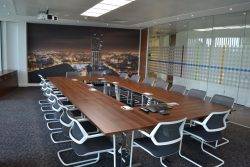 “We are custodians of a lot of data and through FaaS we use it to work with our real estate and design teams to deliver space and workplaces fit for the business.” Using FaaS business engagement, Barclay and his team can understand the headcount that will be permanently based in a facility, those anchored to the building but not permanently there, and the types of roles which influence the desk sharing ratios, collaborative and recreational space as well as client facing and internal meeting facilities. As FaaS includes engaging with business leaders to understand their business plan, GREF is able to plan for growth or contraction in the design and/or lease conditions, to essentially future-proof the business need. The GREF team works with HR and local management to ensure the employee need and workplace experience is met: is a prayer room required? Is a mothers’ room needed? What local employment agreements need to be adhered to? Then IT is engaged to ensure that technology solutions are standardised in the new facility – as an technology sector leader, the company leverages the latest IT and business technology solutions which need to be seamless and ubiquitous.
“We are custodians of a lot of data and through FaaS we use it to work with our real estate and design teams to deliver space and workplaces fit for the business.” Using FaaS business engagement, Barclay and his team can understand the headcount that will be permanently based in a facility, those anchored to the building but not permanently there, and the types of roles which influence the desk sharing ratios, collaborative and recreational space as well as client facing and internal meeting facilities. As FaaS includes engaging with business leaders to understand their business plan, GREF is able to plan for growth or contraction in the design and/or lease conditions, to essentially future-proof the business need. The GREF team works with HR and local management to ensure the employee need and workplace experience is met: is a prayer room required? Is a mothers’ room needed? What local employment agreements need to be adhered to? Then IT is engaged to ensure that technology solutions are standardised in the new facility – as an technology sector leader, the company leverages the latest IT and business technology solutions which need to be seamless and ubiquitous.
EMC is naturally cost conscious and while the firm wants to enable the business and maximise the employee experience, the GREF team doesn’t want to unnecessarily over-invest. A £500,000 fit out for a building with a five year lease, will add circa £100,000 per year in cost to the bottom line (at a local level) through depreciation.” We need to make sure the investment level is right for the business but also that it delivers the right business outcome.”
Further efficiencies and savings are achieved by using preferred furniture, fittings and equipment (FFE) vendors such as Herman Miller and Steelcase and leveraging pricing agreements for office fitout. While using NGO Standard furniture means it can be used in relocations reducing future fit out costs.
The results
For the business, the Next Generation Office has delivered substantial benefits. Employee satisfaction with their workplace – a key driver in the competitive technology world – has increased. More than 85 per cent of respondents to the 2016 customer satisfaction survey across EMEA stated that they were satisfied with their office environment, demonstrating 5 per cent year-on-year growth. When asked ‘Would you recommend your current office to your peers?’ 65 per cent of respondents agreed that they would or already have done so. This is an increase of 7 per cent from the previous year and 10 per cent from 2014.
Research from JLL demonstrates that engaged employees add 147 per cent to business value through higher performance. The NGO programme not only creates a desirable workplace to support talent attraction and retention but also creates the right environment for improved productivity and increased business performance.
Becoming a Great Place to Work was a key target of the programme. In 2014 EMC was listed as a ‘Great Place to Work’ coming in at #18, in 2015 EMC jumped to #6 in World’s Best Multinational Workplaces category. It had not been previously placed in the rankings. The importance of the workplace is now also recognised at board level. Adrian McDonald, President, EMC EMEA says: “From my perspective [the GREF] team plays a significant part in EMC’s business growth and I believe the work they do everyday is integral to the overall success of EMC’s ‘Best Place To Work’ rankings which inspire and motivate our employees and help attract and retain top talent for EMC.”
The GREF programme in EMEA has enabled EMC to accommodate business growth without expanding the property portfolio. The consistent approach to the property portfolio across EMEA has also enabled the team to integrate acquisitions more efficiently and reduce risk. Recently EMC integrated two businesses in EMEA with headcount in excess of 800 without any additional GREF resources while achieving cost synergies and providing more cost effective solutions through the NGO and FaaS offerings.
There are many exciting opportunities ahead for EMC’s global real estate and facilities team as the business continues to grow, such as the merger with Dell and the impact of future technologies including smart and intelligent buildings, and the Next Generation Office becoming the ‘new normal’. While Europe faces an uncertain future, EMC has used its One Team programme and real estate and office design to embed integration across EMEA and is reaping the rewards from this innovative and industry-leading approach.
___________________________________________
 Cathy Hayward is the managing director of Magenta Associates and one of the UK’s foremost writers and commentators on facilities management.
Cathy Hayward is the managing director of Magenta Associates and one of the UK’s foremost writers and commentators on facilities management.





